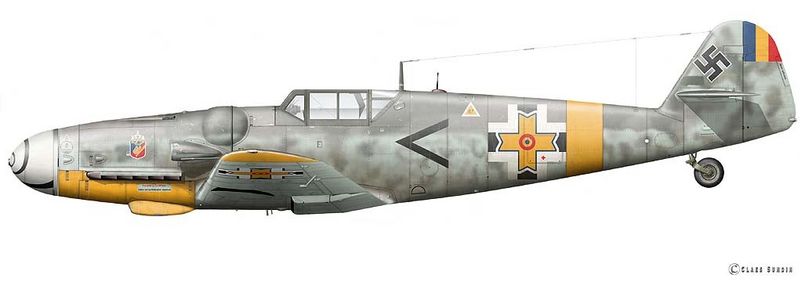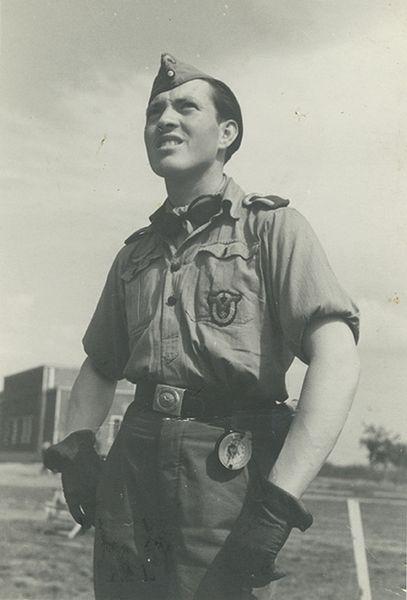Feldwebel Ernst Stengl beim JG 52
Von Beginn des Jahres 1938 an war er als kaufmännischer Lehrling bei der Firma Ferdinand Fuchs in Karlsbad III beschäftigt. Schon Ende September beendete er diese Ausbildung.
Am 15. Januar 1939 begann er eine Ausbildung beim Landratsamt in Karlsbad als Verwaltungslehrling, die er am 30.4.1941 beendete.
Am 1. Mai 1941 kam er in die 1. Kompanie im Flieger - Ausbildungs - Regiment nach Eger. Der Kompanieführer war Oberleutnant Heinrich? Lindau. Diese Ausbildung dauerte bis zum 14. August 1941.
Danach begann für ihn ein Unteroffizierslehrgang bei der gleichen Einheit, der schon nach einer Woche endete.
Am 22. August 1941 wurde er zum Höheren Flieger Ausbildungs-Kommando 13 nach Straubing versetzt. Diese Ausbildung endete am 2. September. Sein Zugführer war der Oberfeldwebel Aberle.
Danach kam er nach Roth bei Nürnberg zur Flugzeugführerschule A / B 111. Der Schulleiter war Hauptmann Johann Böllner.
Bereits am 17. September kam er auf den Arbeitsplatz Amberg dieser Schule. Der Gruppenleiter war Leutnant Siegfried Kossack, sein Fluglehrer war Oberfeldwebel Walzer. Diese Ausbildung dauerte bis zum 17. Februar 1942.
Darauf folgte die Flugzeugführerschule A / B 32 in Pardubitz. Der Schulleiter war hier Major Gerhard Schoen, der Kompanieführer war Oberleutnant Borell und seine Fluglehrer waren der Feldwebel Kaiser und der Unteroffizier Eberhardt. Diese Ausbildung endete am 6. Januar 1943.
Anschließend kam er zur Jagdfliegerschule 7 nach Nancy in Frankreich. Diese Einheit wird später das Jagdgeschwader 107. Der Staffelkapitän war Hauptmann Hermann Staiger (DKG, RK, 63 Luftsiege), seine Jagdlehrer waren Leutnant Emil Lübenau und die Oberfeldwebel Stechmann und Keil. Ein Teil dieser Jagdflieger-Ausbildung erfolgte am Arbeitsplatz Toul. Diese Ausbildung endete am 17. Juli 1943.
Dann kam er zur 2. Jagd-Ergänzungsgruppe Ost in La Rochelle-Laleu in Frankreich. Sein Jagdlehrer war Oberfeldwebel Rudolf Trenkel. Mit bereits 76 Abschüssen kam er vom JG 52 mit dem Ritterkreuz.
Schon am 18. August 1943 wurde er erneut versetzt, er kam zur Luftwaffen-Erprobungsstelle Rechlin, zum Erprobungskommando in Lärz. Der Leiter war Hauptmann Edmund Sorg. Am 20. Oktober 1943 kam er in die 8. Staffel in der III Gruppe des JG 52. Der Gruppenkommandeur war Major Günther Rall, sein Staffelkapitän Leutnant Ludwig Neuböck. Hier flog er seine Einsätze im Raum Ssaporoshje - Kirowograd - Apostolowo - Malaja Wiski und Nowo Krasnoje.
Über dem Brückenkopf von Nikopol galt es vor allem die Il-2 Schlachtflieger zu bekämpfen. Bei der Einweisung erklärte ihm Leutnant Neuböck, wie man am besten diese Maschine abschießen kann. Etwas tiefer angreifen und den Ölkühler treffen. Bei seinem 10. Einsatz am 22.11.43 versuchte er dies. Er schoss und die Il-2 verlor das ganze Leitwerk, ging flachtrudelnd nach unten und explodierte am Boden.
Am 13. Januar 1944 wurde er als Verbindungsmann zu den Rumänen versetzt. Er kam zum Verbindungskommando zum I. Rumänischen Fliegerkorps unter General Deßloch. Er flog hier in der 9. Rumänischen Jagdgruppe („Grupul 9 Vanatoare" ) mit Oberleutnant Neuböck, Kapitän Alexandru Serbanescu und Kapitän Prinz Constantin M. Cantacuzino. Die Plätze und Einsatzräume waren hier Lepeticha, Nikolajew - Ost, Odessa, Tecuci, Roman, Jassy, Buzau, Manzar und Ciora Diejestrje. Es gelangen ihm in dieser Zeit ein B-17 und zwei B-24-Abschüsse. Hier flog er die Bf 109 G-6, „Winkel“ mit der wohl einmaligen, kombinierten deutschen und rumänischen Kennung.
Ende August 1944 kam er zum JG 52 zurück. Herr Stengl schrieb zwar I. Gruppe und 2. Staffel, er kam aber in die II. Gruppe zur 5. Staffel unter Oberleutnant Otto Fönnekold. Der Gruppenkommandeur war Hauptmann Helmut Lipfert. Die Plätze waren hier Sächsisch Regen, Bistritz - Budak und Zilistea.
Er wurde erneut versetzt, er kam am 23. September 1944 in die neu aufgestellte 11. Staffel unter Leutnant Neuböck. Die Plätze und Einsatzräume waren hier Warzyn, Lobellen, Jürgenfelde, Gerdauen, Pobydnik, Klobuk, Gross Stein, Weidengut/ Lamsdorf und Schweidnitz.
Anfang 1945 flog er von Weidengut aus Tiefangriffe und freie Jagd über dem Brückenkopf von Schurgast. Am 21. Januar 1945 bekam er den Auftrag mit seinem Schwarm Tiefangriffe im Bereich des Kohleförderungsgebietes von Kosel auszuführen. Sie überflogen ein großes Waldgebiet und entdeckten auf einer Straße eine Lkw-Kolonne. Sie schossen im Tiefflug und Stengel zog danach hoch und erhielt Flaktreffer. Der Ölkühler wurde getroffen, die Maschine fing an zu brennen und der Öldruck sank. Er drehte in Richtung Heimat und warf das Kabinendach ab. Dann stand der Motor und ihm gelang eine Bauchlandung. Während die Kameraden wieder heimflogen, dachte er daran, dass er wohl noch 10 km hinter der Front war und auch noch die eiskalte Oder dazwischen war. Orte und Straßen meidend, schlug er sich durch. Auch die Oder konnte er schwimmend überqueren. Völlig entkräftet erreichte er die eigenen Linien. Er bekam gleich etwas zu essen und zu trinken und wurde dann von einem Major zu Generalfeldmarschall Schörner gefahren. Der wollte alles über die sowjetischen Truppen wissen, die Stengl tunlichst gemieden hatte. Nachdem er noch geschwächt vom Stuhl gefallen war, wurde er von einem erbosten Schörner entlassen.
Sie flogen auch noch Schlachteinsätze mit 4 mal 50 kg Bomben unter dem Rumpf.
Im Februar 1945 flog die III. Gruppe von Schweidnitz aus Begleitschutzeinsätze für Panzerjäger Hs 129, die mit einer 7,5 cm Kanone ausgerüstet waren. Er verlor dabei einige Kameraden. Von seinem Schwarm waren es der Gefreite Heinz Gräfe und Felix de Sacco. Hier flog auch die 11. Staffel ca. 250 Versorgungseinsätze für das ab Februar 1945 eingeschlossene Breslau. Er selbst flog dabei 11 Einsätze, die nicht ungefährlich waren. Kurz vor Kriegsende, am 11. April 1945 kam er, mit seinem Staffelkapitän Neuböck, zur 6. Staffel in der II. Gruppe nach Österreich zurück. Er nennt die Plätze Linz, Hörsching und Zeltweg. Während zu Kriegsende die Flugzeugführer mit ihren Maschinen von Zeltweg nach Neubiberg flogen und die Bodenmannschaft mit Fahrzeugen in der Kolonne nach Bad Aibling fuhren, flogen, mit einem Fieseler „Storch“, Stengl und Oberleutnant Fritz Nächster zuerst in die Heimat von Nächster, nach Endorf-Halfing am Chiemsee. Hierher wurde die Familie von Nächster aus Breslau evakuiert. Bevor ein Jeep mit amerikanischer Militärpolizei den Hof erreichte, startet er quer über die Kuhweide. Dann flog Ernst Stengl in seine Heimat, Richtung Karlsbad. Bei Erding wurde er noch von 12 P-47 gestellt, aber er konnte den Maschinen entkommen und landete sicher in Karlsbad auf dem Flugplatz. Nach dem Krieg arbeitete Ernst Stengl vom 2. Juni 1945 bis 14. November 1945 bei der Tschechoslowakischen Staatsbahn in Karlsbad.
Herr Stengl verstarb am 10.6.2010.
From the beginning of 1938 he was employed as a commercial apprentice at the company Ferdinand Fuchs in Karlsbad III. Already end of September he ended this education.
At the 15th of January 1939 he started an education at the Municipal Administration in Karlsbad, which ended at the 30th of April 1941.
At the 1st of May 1941 he was send to the 1. Company of the Pilots - Training - Regiment to Eger. The company leader was Oberleutnant Lindau. The training ended at the 14th of August 1941.
After this, startet for him an Unteroffiziers course at the same unit, which already ended after one week.
At the 22nd of August 1941 he was ordered to the Higher Pilots - Training - Commando 13 at Straubing. This training ended at the 2nd of September. His platoon leader was Oberfeldwebel Abele.
After this, he was transferred to Roth near Nürnberg, to the Pilots training school A / B 111. The leader here was Hauptmann Böllner.
Already at the 17th of September he was ordered to the additional airfield Amberg of this school. The group commander was Leutnant Kossak, his flight trainer was Oberfeldwebel Walzer. This training ended at the 17th of February 1942.
After this, he was ordered to the Pilots Training School A / B 32 at Pardubitz. The leader here was Major Schoen, the company leader was Oberleutnant Borell and his flight trainers were Feldwebel Kaiser and Unteroffizier Eberhardt. This training ended at the 6th of January 1943.
Then he was sent to the Fighter Pilots School 7 at Nancy in France. This unit later became Jagdgeschwader 107. The Staffelkapitän was Hauptmann Staiger, his flight trainers were Leutnant Lübenau and the Oberfeldwebels Stechmann and Keil. A part of this fighter pilots training happened at the additional airfield Toul. This training ended at the 17th of July 1943.
Then he was transferred to the 2. Fighter Supplement Group East at La - Rochelle - Laleu in France. His flight trainer was Oberfeldwebel Rudolf Trenkel. With already 76 victories he came from the JG 52 with his knights cross.
Already at the 18th of August 1943 he was transferred once more, he joined the Airforce - Testing Unit at Rechlin, to the Testing Commando at Lärz. The leader was here Hauptmann Sorg.
At the 20th of October 1943 he moved to the 8th Staffel in the III Group of JG 52. The Group -commander was Major Rall, his Staffelkapitän was Leutnant Neuböck. Here he flew missions in the areas of Ssaporoshje - Kirowograd - Apostolowo - Malaja Wiski and Nowo Krasnoje. Over the bridgehead of Nikopol, the most important thing was to fight against the Il-2. At the briefing Leutnant Neuböck explained to him, the best way to bring an Il-2 down. To fly a little bit lower and to hit the oilcooler. During his 10th mission at the 22nd of November 1943 he tried that. He fired and the Il-2 lost the whole tail section, got into a flat spin and exploded at the ground.
At the 13th of January 1944 he was ordered as liaison pilot to the Romanians. He got to the Liaison - Commando of the 1. Romanian Flying Corps under General Deßloch. He flew here within the 9. Romanian Fighter Group ( “Grupul 9 Vanatoare” ) with Leutnant Neuböck, Captain Alexandru Serbanescu and Captain Prince Constantin M. Cantacuzino. The airfields and the operational areas were Lepeticha, Nikolajew - Ost, Odessa, Tecuci, Roman, Jassy, Buzau, Manzar and Ciora Diejestrje. He claimed for this time one B-17 and two B-24 victories. He flew here with a Bf 109G-6, “Chevron”, with the unique, combined German and Romanian marking.
End of August he returned to the JG 52. He wrote I. Group and 2. Staffel, but actually he came to the II. Group and 5. Staffel under Oberleutnant Fönnekold. The Groupcommander was Hauptmann Lipfert. The airfields were Sächsisch Regen, Bistritz - Budak and Zilistea.
He had to move once more, he was transferred at the 23rd of September 1944 to the new established 11. Squadron under Leutnant Neuböck. The airfields and the operational areas were Warzyn, Lobellen, Jürgenfelde, Gerdauen, Pobydnik, Klobuk, Gross Stein, Weidengut/ Lamsdorf and Schweidnitz.
At the beginning of 1945 he started from Weidengut low level attacks and “free hunt” over the bridgehead of Schurgast. At the 21st of January 1945 he got the order, together with his flight, to run low level attacks in the coal mining area near Kosel. They flew over a big wooden area and found a street with a truck convoy on it. They fired at low level, Stengl pulled up and got a flak hit. The oil cooler was hit, the aircraft started to burn and the oil pressure went down. He turned to the home direction and released the cabin roof. Then the engine stopped and he performed a “wheels up” landing. Whilst the comrades flew home, he thought about, that he is 10 km behind the front line and also the icecold Oder river is in between. Avoiding places and streets he fought his way through. He also crossed swimming the Oder river. Without any power he reached the own lines. Immediately he got something to eat and to drink and then a Major drove him to Generalfeldmarschall Schörner. He wanted to know everything about the soviet troops, Stengl had avoided them as much as possible. After he felt powerless from the chair, he was released from the angry Schörner.
In February 1945 the III. Group flew from Schweidnitz cover for the tankhunter Hs 129, equipped with a 7,5 cm gun. Some comrades got MIA. From his flight Gefreiter Heinz Gräfe and Unteroffizier Felix de Sacco. From this field the 11. Staffel flew also about 250 supply missions for the city of Breslau, which was isolated since February 1945. He flew 11 flights of this dangerous missions. Before the end of the war, at the 11th of April 1945 he was ordered, together with his Squadron leader Oberleutnant Neuböck, to the 6. Staffel within the II. Group, back to Austria. He remembered the airfields Linz, Hörsching and Zeltweg. Whilst, at the end of the war, the pilots with their aircrafts flew from Zeltweg to Neubiberg and the ground crew with their vehicles drove in colums to Bad Aibling, Stengl and Oberleutnant Nächster flew with a Fieseler “stork” to the home of Nächster, to Endorf - Halfing at the Tegernsee. To this place the family of Nächster was evacuated. Before a Jeep with American military police arrived, he took off across the cow meadow. Then Stengl flew home, direction Karlsbad. Near Erding he was stopped by 12 P- 47, but he could escape and landed safely at the airfield of Karlsbad.
He died at 10.6.2010.
01.02.1942 - Gefreiter
01.12.1942 - Unteroffizier
01.12.1944 - Feldwebel
05.06.1944 - EK II
04.11.1944 - EK I
01.12.1944 - Goldene Frontflugspange für Jäger
8. / JG 52
- 22.11.1943, 12.40 Uhr, Il-2H, NW Beloserka, SU
- 22.02.1944, 12.17 Uhr, Jak, Salataya Balka, SU
- 30.05.1944, 09.40 Uhr, P-39, NW Jassy, RO
- 31.05.1944, 11.40 Uhr, Il-2, NO Jassy, RO
- 01.06.1944, 11.25 Uhr, P-39, SO Tudora, RO
- 11.06.1944, 09.55 Uhr, B-17, Focsani, RO
- XX.07.1944, ?, P-38, Focsani, RO
11. / JG 52
- 20.10.1944, 15.00 Uhr, Il-2H, PQ 25415
- XX.02.45, ?, Jak-9, R Brieg / Oppeln
- XX.03.45, ?, Jak-9, ?
Während der Abstellung zu den Rumänen erzielte er zwei weitere Abschüsse von B-24, die aber nicht bestätigt wurden. Nach eigenen Angaben erzielte er insgesamt 17 Abschüsse.
16.10.44
11. St, Fw. Ernst Stengl, Bauchlandung nach Luftkampf an der HKL, Bruch 100%, Schlossberg, Ostpreußen. Bf109G-?, WNr.?, Kennung ?
20.01.45
11. St., Fw. Ernst Stengl, Bauchlandung nach Flakbeschuss 10 km hinter der Front und zurück. Bruch 100 %, S Gross Strehlitz, Bf109G-14, WNr. ?, Kennung ?
Briefe, Listen und Fotos von Ernst Stengl, 1995 und 2003
Luftwaffe Aces, Band 4 von Matthews und Foreman
Fotos bei Flickr über Haldimann auf „TOCH“ von „Un Document Descoperit De Utopia Film“
Wappen der „Grupul 9 Vanatoare" über Denes Bernad
Auszug aus Me 109 von Peter Schmoll im MZ Verlag, Artikel über Denes Bernad
Internet, Luftwaffe Officers Careers Summaries, H. Zeng und D. Stankey
Fotos / Pictures Stengel
-
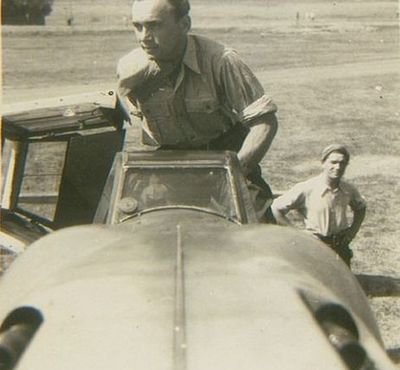 Stengl in seiner Bf109G-6 auf einem rumänischen Flugplatz. Sein Wart im Hintergrund. Der handschriftliche Text ist sehr schlecht lesbar.
Stengl in seiner Bf109G-6 auf einem rumänischen Flugplatz. Sein Wart im Hintergrund. Der handschriftliche Text ist sehr schlecht lesbar. -
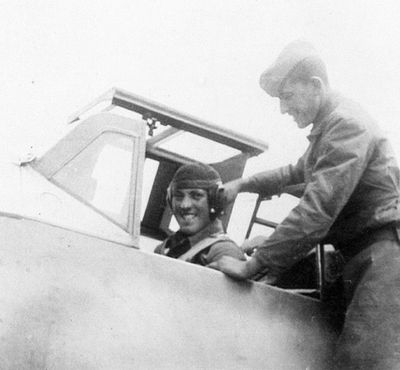 Ernst Stengl in der „Winkel“ bei den Rumänen. „Nach meinem 5. Abschuss mit meinem rumänischem 1. Wart, Gr.9 Vanatoare, Rumänien, Tecuci, 1.6.44“
Ernst Stengl in der „Winkel“ bei den Rumänen. „Nach meinem 5. Abschuss mit meinem rumänischem 1. Wart, Gr.9 Vanatoare, Rumänien, Tecuci, 1.6.44“ -
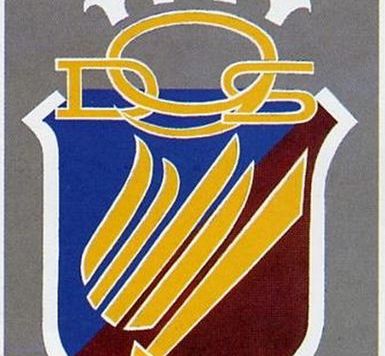 Wappen der „Grupul 9 Vanatoare“
Wappen der „Grupul 9 Vanatoare“
